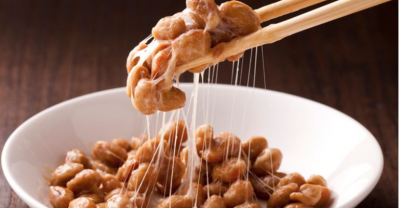How To Make Natto

Natto is a fermented food made by fermenting soybeans using bacteria called "Bacillus subtilis". However, whilst living in Spain, I had no starter so decided to experiment with fermenting the beans using cabbage leaves. The outcome was excellent.
Natto is considered a superfood for its amazing properties. It is protein rich with a wide range of amino acids. Natto is high in calcium, iron, vitamin K and wide range of minerals. It has a unique nutrient know as vitamin K2 that research claims reduces the incidence of internal blood clots, reducing the risk of strokes.
According to the oldest tale surrounding the creation of natto, it was thought up somewhere around the 10th century BC and the middle of the 3rd century AD. It is believed that it started getting sold as a product in the Edo period (1603 – 1868), eventually becoming a standard part of the Japanese breakfast. It is extremely popular as a healthy delicacy, possessing plenty of Vitamin K, soy protein, and dietary fibre which aids in constipation. Since it is a fermented food, it does give off a special smell that comes from the bacteria. Due to its unique stickiness, texture, and taste, it is a food that some people don’t like, it is an acquired taste. It has a flavour that has been described as akin to fermented cheese. it is often served with condiments such as sliced green onions, wasabi or pickled ginger.
Soybeans Wrapped In Rice Straw
It’s not quite certain when or who first discovered that wrapping cooked soybeans in rice straw for a while would make them ferment and become soft and sticky. The earliest written record of nattō is from around the mid-11th century, but it is fairly certain that the food itself existed way before then.
The bacillus bacteria that turn soybeans into nattō, bacillus subtilis or bacillus nattō, live on rice straw, and since both rice and soybeans have existed in Japan since prehistoric times, it’s quite likely that nattō has been made since then, too. The old-fashioned way, by wrapping boiled soybeans in straw and keeping them in a warm place for a few days, gave me the idea to wrap them in cabbage leaves, as bacteria live on them as well. Lactobacillus plantarum is the most popular lactic acid bacteria strain, and it ferments sauerkraut, pickles, cheese and even meat.
There are a lot of good reasons to try using natto in your diet. Whole cooked soybeans are packed with protein, fibre and other nutrients, but the fermentation process makes nattō even more beneficial to health: It adds probiotics, which help with digestion as well as strengthening the immune system. It’s also packed with vitamin K, which is found in leafy greens, as well as vitamin PQQ (pyrroloquinoline quinone), which may help your body’s cells to metabolise.
Nattokinase
Natto has the highly beneficial nattokinase probiotic enzyme. Nattokinase is known to aid in digestive disorders, especially those caused by antibiotic use. Nattokinase is essential in proper blood clotting mechanisms and has even been suggested to break down the plaque associated with Alzheimer’s disease.
PQQ
Vitamin PQQ, which has been linked to skin health, is very high in natto. This amazing vitamin helps restore elasticity to your skin and regain a few lost years when consumed regularly. We enjoy natto daily, added to our short-grain brown rice morning porridge. The benefits of natto are innumerable, from reducing bone loss, improving heart and brain health, gut health, reducing cancer risks, and the fermentation process treats numerous health diseases.
How I Make Natto
1 1/2 cups organic soybeans
Cabbage leaves
Baking Tray
Coolbox
Glass jars
Wash and rinse the soybeans. Soak for a maximum for 10 hours, the beans will absorb to at least double in size. Place in a pressure cooker with enough water to cover and bring to a boil. Skim off the foam that arises and when the foam ceases, cover the pressure cooker and cook at low heat for 30 minutes. Remove from the heat and allow the pressure to come down naturally. If you don't have a pressure cooker, use an open pot, however, you will have to add water as the beans cook. Follow the same format, skimming off the foam, then cover and cook over medium heat until the beans are soft.
Drain the beans and set aside. Cover the base of the baking tray with the cabbage leaves, discarding any hard stems, so the leaves lay flat. Spread the beans on top and then cover with a layer of cabbage leaves, tucking in the sides of the tray. Transfer the tray to your coolbox or any other box with a tight lid you may have to hand. Place one or two sushi mats on top to avoid squashing the beans when you add your water bottles or jars. Fill your glass jars with hot water from the tap and place in each corner of the box or depending on the size of your jars or bottles that may lie horizontally.
I refreshed the warm water every 12 hours for a period of 36 hours. Perfectly fermented stringy sticky natto was the result. Your choice to freeze in portions or refrigerate. Freezing stops the fermentation process and preserves the stickiness. Without refrigerating the natto will lose its stickiness and continue to ferment.
Note: In Spain, the fermentation happened simply with the cabbage leaves but here in the U.K. damp wet winter right now, you must follow the method above.
Summary: Natto contains fibre, probiotics, vitamin K2 and nattokinase. This combination may help reduce cholesterol and blood pressure levels and decrease the risk of heart disease.
In good health


